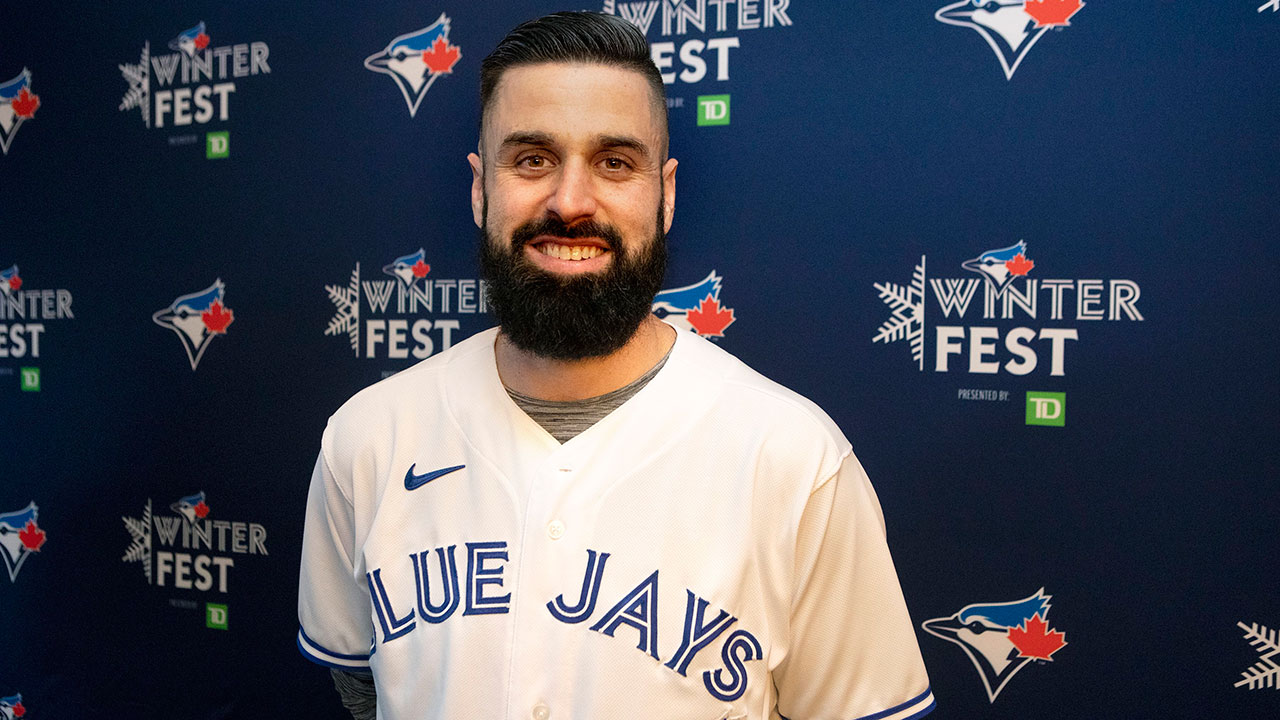TORONTO — Last fall, not long after the Toronto Blue Jays disappointing, rebuilding, 95-loss season came to its bitter end, Matt Shoemaker got together with around 10 of the club’s younger players in Dunedin, Fla. Nothing formal — just teammates hanging out while they were all in the same area. But the topic of the club’s future obviously came up as the night wore on. And everyone agreed they needed to be hanging out together like that as a team more often.
“Great teams have that. There’s always camaraderie in a clubhouse and on the field. But when you can better build those relationships off the field, it directly correlates. You win more games,” Shoemaker said Saturday during Blue Jays Winter Fest at Rogers Centre. “I’ve seen both sides. I’ve been on teams when it’s happened. When you get these tight-knit groups and guys start to hang out with each other and trust each other, that’s when something really cool can happen.”
That commitment to team-building and unity is what the Blue Jays have been trying to build organizationally for years now, both through a revamped player development program and selective additions of team-first veterans like Shoemaker.
Blue Jays rookies have participated in teamwork and leadership programs with U.S. Army Rangers, an initiative that continued this week as more than a dozen prospects and staff spent several days working with Canadian Armed Forces personnel in Petawawa, Ont.
A skill development camp is also being held in Dunedin this week, intended to help younger players seeking to make substantial adjustments work in a collaborative environment under the watch of Blue Jays coaches and coordinators.
And any acquisition made this off-season — from the fun-loving, gregarious Hyun-Jin Ryu to the ever-evolving, analytically-minded Chase Anderson — has involved a thorough character background check with an eye towards building a positive, cohesive clubhouse.
“Being a tight-knit team, having everyone contributing, really meshing with each other — we definitely have that in mind. I was just talking about it with some of the guys this morning,” Shoemaker said. “It shows up on the field. That’s when you go out there and have so much fun. And just win.”
To that end, Toronto’s revamped rotation this season will also serve as its core of veteran leadership. Shoemaker and free agent addition Tanner Roark are the oldest players currently on the club’s 40-man roster, followed closely behind by fellow starters Ryu and Anderson. Japanese right-hander Shun Yamaguchi and reliever Anthony Bass are the only other players on the 40-man roster to have hit 30.
As things stand now, they’ll all be on the club come opening day, with Ryu, Shoemaker, Roark, and Anderson forming the top of Toronto’s rotation, and a group of younger pitchers — Ryan Borucki and Trent Thornton chief among them — competing for the fifth and final spot. The most volatile part of Toronto’s 2019 roster suddenly appears to be an area of stability and confidence. And how much impact can a crew of experienced, thoughtful veteran starters make on a team’s clubhouse?
“A lot,” said Blue Jays manager Charlie Montoyo. “The kids, they’re going to see how a guy like Shoemaker works. You know, Shoemaker’s not only a good pitcher — he’s a great guy. And then Chase Anderson; Tanner Roark is awesome. We not only have good pitching — they’re good people, too. So, it’s going to be a good clubhouse.”
Borucki was part of the group that went out with Shoemaker last fall and says he already has plans to ask Ryu how he throws the cutter he introduced in 2017. Borucki’s been trying to introduce a cutter to his repertoire for years with little success, not that he’s had much opportunity to work on it of late.
The 25-year-old missed all but two starts of his 2019 season due to elbow issues that eventually required surgery to remove some troublesome bone spurs. It was far from Borucki’s first injury — he’s lost three seasons to different surgeries during his young career — but it was still a learning experience for the left-hander, who says he needed to do a better job communicating the discomfort he was experiencing with Toronto’s training staff.
That’s the kind of lesson that can be passed down from an experienced teammate rather than being learned the hard way. Remember, it was Justin Smoak who encouraged Bo Bichette to report his concussion symptoms late last season. Maybe things play out differently if Borucki had different veteran resources on the pitching staff around him.
But what’s done is done, and Borucki’s just happy he finally got back on a mound this week to throw his first bullpen in six months. He plans to throw a half-dozen more prior to spring training before entering a camp in which he’ll have to earn a big-league job lest the Blue Jays choose to utilize the minor-league option he has remaining.
“It’s going to be fun. Everybody that’s competing for these jobs are all good guys. Everybody’s a good teammate and wants everybody to do well,” Borucki said. “If Trent goes out there and pitches well, he’s going to want me to do well, too. And hopefully I pitch better and he’s like, ‘All right, I’m going to go out there [and pitch well] again.’”
You might think Thornton feels a little hard-done-by having to participate in that competition, considering he spent his entire 2019 season in Toronto’s rotation, leading the team with 154.1 innings pitched. But he says he welcomes it, and will be in better shape this spring than he was in 2019 after a much-needed break from the game this winter.
Following a full 2018 minor-league season in Houston’s organization, Thornton pitched an additional month in the Arizona Fall League, was traded, and ended up bouncing between relief appearances and starts with the Blue Jays in spring training before he had time to catch his breath. There was no time for rest. So, after his taxing 2019, Thornton took a full month off to allow himself to recover and didn’t throw a baseball for six weeks.
“My body feels significantly better. I feel the strongest I’ve ever felt. I’ve been working out extremely hard and I’ll be carrying a little chip on my shoulder going into spring training,” Thornton said. “We’re looking to win; we’re looking to compete. And bringing in these veteran arms, it’s a good sign. It brings more competition for us young guys. We’re going to be able to learn a lot more, pick their brains, and help the whole team in general.”
Thornton started getting to know some of those veterans at a team retreat earlier this month in Florida, including Anderson, who’s relied on a strong curveball throughout his career like Thornton does. Anderson’s gone through an evolution with the pitch, making a significant grip adjustment — he now calls it a “spike curveball” — last season in response to persistent location issues.
Leaning more on a recently-developed cutter helped Anderson get through the starts when he didn’t have command of his curve, but he plans to bring four reliable pitches into Blue Jays camp next month. Working with former Milwaukee Brewers pitching coach Derek Johnson, Anderson spent time using Rapsodo and Trackman data to continue evolving, finding new ways to get hitters out with less-than premium stuff. Anderson’s fastball features a below-average spin rate, for instance, but he throws it with above-average spin efficiency on an axis that helps set up his curveball.
“If I can get that curveball to come off that axis with the same spin, obviously different direction, it’s going to come off that pitch and look like the same thing in my hand,” Anderson said. “I’ve learned where to throw those pitches. I’ve looked at the data on where I get hurt and where I don’t get hurt. So, you try to stay away from those spots that you get hurt.”
Which gets at another one of those values you hear Blue Jays management harping on again and again — using information to learn and improve in a collaborative environment. Many fans roll their eyes at the buzz words. But you can see the culture Toronto’s front office has been striving to build on this season’s roster more than ever.
Young players developed in a minor-league system that rewards diligence and constant improvement. Open-minded veterans with strong reputations as clubhouse leaders and supportive teammates. A robust coaching staff blending younger, analytically-minded instructors and more experienced, perceptive tacticians. Everyone’s a baseball rat, everyone’s buying into the vision, and everyone’s convinced this is how they’re going to win.
Whether or not the Blue Jays do will ultimately decide just how successful this organizational makeover has been. No one will want to hear about development and team-building exercises if the Blue Jays lose 95 times again in 2020. But that isn’t this team’s expectation.
Part of the conversation Shoemaker and his young teammates had back in fall was about how positive everyone felt in the final weeks of the 2019 season, as the Blue Jays turned the lineup over fully to the organization’s younger players and let them run as far as they could. Toronto won 12 of its final 18 games — all of them against division rivals — as rookie after rookie took turns coming up with big moments. Not long after that stretch, they all sat around and talked about how that run shouldn’t only be the end of a grim season, but the beginning of a bright future.
“Watching it in September, watching what this club was capable of doing — I was like, ‘We need to take that and build off that,’” Shoemaker said. “Because it was exciting. We all saw it. It was super exciting. The talent level, what the team could do, going out there and winning — we’re going to build off of that.”
[relatedlinks]









